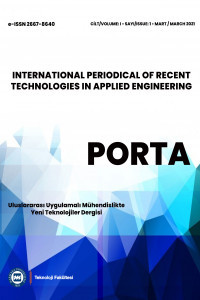Antibacterial Properties of Polyurethane / Benzalkonium Chloride Nanofibers
Electrospinning, benzalkonium chloride, antibacterial, nanofiber
___
- [1] Matos, J. C., Avelar, I., M. Bárbara F. Martins, Gonçalves, M. C., (2017), Greensilica® vectors for smart textiles; Carbohydrate Polymers, 156, 268-275.[2] Ju, J., Shi, Z., Fan, L., Liang, Y., Kang, W., Cheng B., (2017), Preparation of elastomeric tree-like nanofiber membranes using thermoplastic polyurethane by one-step electrospinning, Materials Letters, 205, 190–193.[3] Pal, J., Wu, D., Hakkarainen, M., Srivastava, R. K., (2017), The viscoelastic interaction between dispersed and continuous phase of PCL/HA-PVA oil-in-water emulsion uncovers the theoretical and experimental basis for fiber formation during emulsion electrospinning, European Polymer Journal, 96, 44–54.[4] Guyomar, D., Lebrun, L., Putson, C., Cottinet, P. J., Guiffard, B., Muensit, S., (2009), Electrostrictive energy conversion in polyurethane nanocomposites, J. Appl. Phys. 106, 014910.[5] Gaber, M., Shawish, H.M.A., Khedr, A.M., Abed-Almonem, K.I., (2012), Determination of benzalkonium chloride preservative in pharmaceutical formulation of eye and ear drops using new potentiometric sensors, Mater. Sci. Eng. C 32, 2299-2305.[6] Khil, M.S., Cha, D.I., Kim, H.Y., Kim, I.S., N. Bhattarai, (2003), Electrospun nanofibrous polyurethane membrane as wound dressing, J. Biomed. Mater. Res. Part B:Appl. Biomater., 67B, 675-679.[7] Lakshman L., K. T. Shalumon, V. Sreeja, R. Jayakumar & S. V. Nair, (2010), Preparation of Silver Nanoparticles Incorporated Electrospun Polyurethane Nano-fibrous Mat for Wound Dressing, Journal of Macromolecular Science, Part-A: Pure and Applied Chemistry, 47(10), 1012 – 1018.[8] Li X., Lou, W., Song, R., (2009), Experimental Investigation of Polyurethane Electrospun Nanofıbers Mat - Relationship Between Mechanical Property and Thickness, IEEE 3rd International Conference on Nano/Molecular Medicine and Engineering, 1-4.[9] Unnithana, A. R., Gnanasekaran, G., Sathishkumar, Y., Lee Y. S., Kim C. S., (2014), Electrospun antibacterial polyurethane–cellulose acetate–zeincomposite mats for wound dressing, Carbohydrate Polymers, 102, 884– 892.[10] Toncheva, A., Spasova, M., Paneva, D., Manolova, N., Rashkov, I., (2011), Drug-loaded electrospun polylactide bundles, Journal of Bioactive and Compatible Polymers, 26(2), 161–172.[11] ISO 20645., (2004), Determination of antibacterial activity-agar diffusion plate test, Technical Committee CEN, TC, 248.[12] Cheng, C.-L., Sun, D.-S., Chu, W.-C., Tseng, Y.-H., Ho, H.-C., Wang, J.-B., others, (2009), The effects of the bacterial interaction with visible-light responsive titania photocatalyst on the bactericidal performance, Journal of Biomedical Science, 16(1), 7.[13] Kimiran Erdem, A., Sanli Yurudu, N. O., (2008), The evaluation of antibacterial activity of fabrics impregnated with dimethyltetradecyl (3-(trimethoxysilyl) propyl) ammonium chloride, IUFS Journal of Biology, 67(2), 115–122.
- Başlangıç: 2019
- Yayıncı: Marmara Üniversitesi
PU Kaplamalı Kumaşlarda Ultrasonik Dikişin Su Geçirgenliğinin Araştırılması
Ayşe ŞEVKAN MACİT, Bahar TİBER
Nano-akışkan Aşındırıcı Toz Miktarının Yüzey Kalitesine Etkilerinin İncelenmesi
Ahmet Emre ÖZCAN, Mustafa AY, Ayhan ETYEMEZ
Ayfer İrem KOCA, Mustafa Erdem ÜREYEN, Gamze YÜKSEL, Fadime KARAER
Antibacterial Properties of Polyurethane / Benzalkonium Chloride Nanofibers
